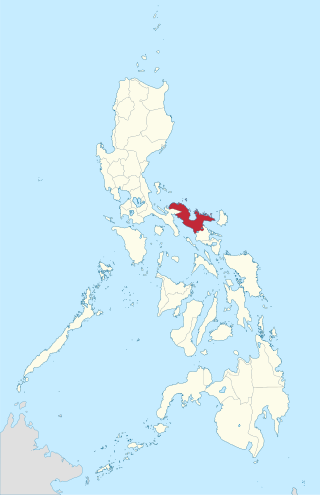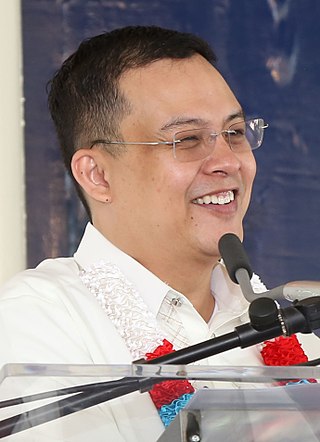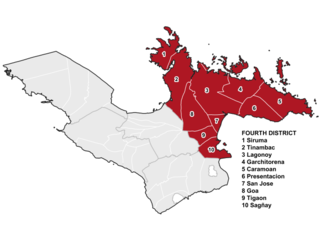Related Research Articles

Camarines Sur, officially the Province of Camarines Sur, is a province in the Philippines located in the Bicol Region on Luzon. Its capital is Pili and the province borders Camarines Norte and Quezon to the northwest, and Albay to the south. To the east lies the island province of Catanduanes across the Maqueda Channel.

Goa, officially the Municipality of Goa, is a 1st class municipality in the province of Camarines Sur, Philippines. According to the 2020 census, it has a population of 71,368 people.

Ambos Camarines, officially the Province of Ambos Camarines, was a historical province in the Philippines found on the northern end of the Bicol Peninsula. It now exists as two separate provinces: Camarines Norte and Camarines Sur.
The legislative districts of Ambos Camarines were the representations of the historical province of Ambos Camarines in the various national legislatures of the Philippines until 1919.
Partido State University is a research regional state higher education institution in Partido Area at the province of Camarines Sur, Philippines. It is an ISO 9001:2015 certified public university.

Arnulfo Palma Fuentebella was the Speaker of the Philippine House of Representatives from 2000 to 2001. He was also a representative of the 3rd district of Camarines Sur, more popularly known as the Partido district.

Tomás Arejola y Padilla was a Filipino lawyer, legislator, diplomat, political writer and a propagandist during the Spanish colonial period. A mason and a liberal, he openly campaigned for political reforms in the Philippines. But this was to pass and the Americans took over. During the Commonwealth period, Arejola joined the Nacionalista Party becoming its first vice-president and twice in the elections of 1907 and 1911 was elected the Representative of Ambos Camarines.
Nueva Camarines is a proposed province of the Philippines to be created out of Camarines Sur in the Bicol Region of the island of Luzon. The proposed province would border Camarines Sur to the west, the Philippine Sea to the north, Albay to the south, and to the east the island province of Catanduanes across Maqueda Channel. Its capital is expected to be Tigaon if the bill is passed.
Paz Cea de Conde was the first woman member of the provincial board of Camarines Sur, and the first woman governor of the Philippines. She served as governor in 1937–38 by succeeding her brother, Gerardo Fuentebella Cea.

Felix William Buquid Fuentebella is a lawyer and politician who was the former representative of the 4th and 3rd district of the Province of Camarines Sur, which is popularly known as the "Partido District".
Mariano Benitez Fuentebella was the Governor of Ambos Camarines from 1912 to 1916. He is considered as the "Patriarch" of the Fuentebella family clan of Camarines Sur.
José Tria Fuentebella, widely known as "Pepe", was a Filipino politician. He is the first Fuentebella to foray into the national arena of politics.
Felix Abad Fuentebella was the Representative of the Second District of Camarines Sur in the Philippines from 1954 to 1972 and the Provincial Governor of Camarines Sur from 1976 until 1986. He is the son of former Ambos Camarines Governor Mariano Fuentebella and the half brother of Jose Fuentebella and Manuel Fuentebella.

Arnulf Bryan "Arnie" Buquid Fuentebella is the incumbent representative of Camarines Sur's 4th district in the Philippines. He is also the former Municipal Mayor of Tigaon in the province of Camarines Sur.
Evelyn Buquid Fuentebella widely known as Nanay Belen, is the Municipal Mayor of Sagñay in the province of Camarines Sur, Philippines, serving from 2010 until 2019. She is the wife of former Speaker of the Philippine House of Representatives Arnulfo Fuentebella.
Camarines Norte's at-large congressional district refers to the lone congressional district of the Philippines in the province of Camarines Norte for various national legislatures before 2010. The province first elected its representatives provincewide at-large in 1919 following the dissolution of Ambos Camarines into the present provinces of Camarines Norte and Camarines Sur. It was a single-member district for the final six legislatures of the Insular Government of the Philippine Islands from 1919 to 1935, the three legislatures of the Commonwealth of the Philippines from 1935 to 1946, the seven congresses of the Third Philippine Republic from 1946 to 1972, the national parliament of the Fourth Philippine Republic from 1984 to 1986, and the 8th to 14th congresses of the Fifth Philippine Republic from 1987 to 2010.
Ambos Camarines's at-large congressional district may refer to one occasion when a provincewide at-large district was used in an election to a Philippine national legislature from the historical province of Ambos Camarines. The former province was represented by four representatives in the National Assembly of the First Philippine Republic in 1898 following its reorganization under Article 6 of the Decreto de 18 junio de 1898 y las instrucciones sobre el régimen de las provincias y pueblos. It elected two members to the nascent Malolos Congress with two more members having been appointed by the same congress. The district was abolished after the fall of the First Republic and the start of American rule in 1901. Ambos Camarines was immediately reestablished as a province in the same year and elected its representatives to the Philippine Assembly from three congressional districts created under the Philippine Commission Act No. 1582 on January 9, 1907.

Camarines Sur's 4th congressional district is one of the five congressional districts of the Philippines in the province of Camarines Sur. It has been represented in the House of Representatives since 1987. The district consists of municipalities in the Partido region of eastern Camarines Sur, namely Caramoan, Garchitorena, Goa, Lagonoy, Presentacion, Sagñay, San Jose, Siruma, Tigaon and Tinambac. It is currently represented in the 18th Congress by Arnulf Bryan Fuentebella of the Nationalist People's Coalition (NPC).
References
- Building Institutions: The Fuentebella Legacy by Coylee Gamboa
- http://www.congress.gov.ph/ Official Congress Website